Félix Bracquemond
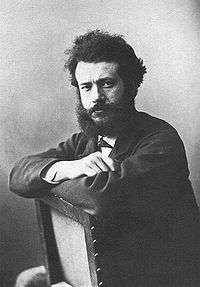
Félix Henri Bracquemond (May 22, 1833 – October 29, 1914) was a French painter and etcher.
Biography
Félix Bracquemond was born in Paris. He was trained in early youth as a trade lithographer, until Guichard, a pupil of Ingres, took him to his studio. His portrait of his grandmother, painted by him at the age of nineteen, attracted Théophile Gautier's attention at the Salon. He applied himself to engraving and etching about 1853, and played a leading and brilliant part in the revival of the etcher's art in France. Altogether he produced over eight hundred plates, comprising portraits, landscapes, scenes of contemporary life, and bird-studies, besides numerous interpretations of other artist's paintings, especially those of Jean-Louis-Ernest Meissonier, Gustave Moreau and Jean-Baptiste-Camille Corot. After having been attached to the Sèvres porcelain factory in 1870, he accepted a post as art manager of the Paris atelier of the firm of Haviland of Limoges. He was connected by a link of firm friendship with Édouard Manet, James McNeill Whistler, and all the other fighters in the impressionist cause, and received all the honors that await the successful artist in France, including the grade of Officer of the Legion of Honor in 1889.[1]
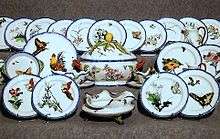
Bracquemond was a prominent figure in artistic and literary circles in the second half of the 19th century. He was close to writers such as Edmond de Goncourt and critic Gustave Geffroy, and numbered among his friends Millet and Corot, Henri Fantin-Latour, Degas and the Impressionist circle, and Auguste Rodin. He was one of the more prolific printmakers of his time and he was awarded the grande medaille d'honneur at the Universal Exhibition of 1900. He was also a painter, ceramist, and an innovator in decorative arts. Gabriel Weisberg called him the "molder of artistic taste in his time".[3] Indeed, it was he who recognised the beauty of the Hokusai woodcuts used as packing around a shipment of Japanese china, a discovery which helped change the look of late 19th-century art.[4]
He married French Impressionist artist Marie Bracquemond in 1869. He died in Sèvres.
Gallery
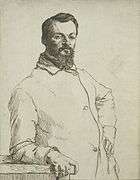 Alfred de Curzon, 1850s
Alfred de Curzon, 1850s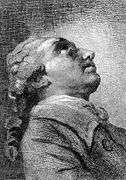
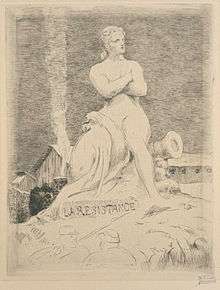 "La statue de la Résistance" par Falguière, 1870
"La statue de la Résistance" par Falguière, 1870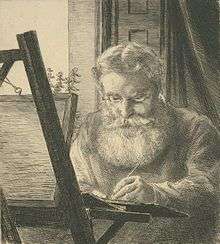 Edwin Edwards 1872
Edwin Edwards 1872 Terrace of the Villa Brancas 1876
Terrace of the Villa Brancas 1876- Death Mask of
Auguste Blanqui, 1881 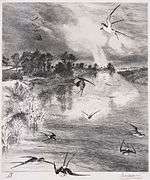 Les Hirondelles,
Les Hirondelles,
ca. 1882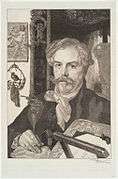 Portrait of
Portrait of
Edmond de Goncourt, 1882 Portrait of Auguste
Portrait of Auguste
Poulet-Malassis, 1884
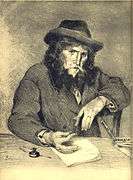 Portrait of
Portrait of
Léon Cladel, 1905 Portrait of
Portrait of
Alphonse Legros
Decorative Arts
References
| Wikimedia Commons has media related to Félix Bracquemond. |
- ↑
 One or more of the preceding sentences incorporates text from a publication now in the public domain: Chisholm, Hugh, ed. (1911). "Bracquemond, Félix". Encyclopædia Britannica (11th ed.). Cambridge University Press.
One or more of the preceding sentences incorporates text from a publication now in the public domain: Chisholm, Hugh, ed. (1911). "Bracquemond, Félix". Encyclopædia Britannica (11th ed.). Cambridge University Press. - ↑ Musée d'Orsay, "Art, industry and japonism : the "Rousseau" set"
- ↑ Weisberg, Gabriel (September 1976). "Félix Bracquemond and the Molding of French Taste". Artnews: 64–66.
- ↑ Bouillon, Jean-Paul (1980). "Remarques sur la Japonisme de Bracquemond". Japonisme in Art, Art Symposium. Tokyo: Kodansha International: 83–108.